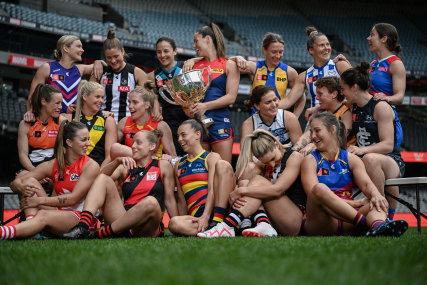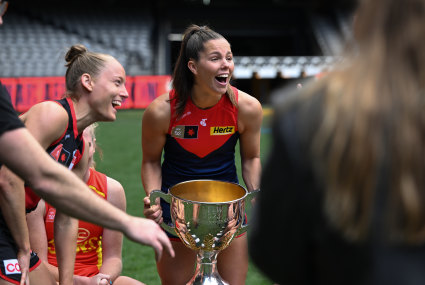‘Invest in us’: Equal prizemoney for AFLW as league urged to follow Matildas’ lead
Save articles for later
Add articles to your saved list and come back to them any time.
The AFL men’s and women’s competitions will receive equal prizemoney for the first time, in a move considered a step closer to addressing the large pay disparity between the two leagues.
The $1.1 million prize pool announcement comes as AFLW captains push for a stronger marketing strategy that showcases the players’ personalities to attract new audiences, taking a leaf out of the Matildas’ strategy that flooded social media feeds during the Women’s World Cup.
The AFLW captainsCredit: Joe Armao
The official launch of the 2023 AFLW season on Monday, the day after the Women’s World Cup final, was marked by the announcement that this season’s prizemoney for the players will almost double from last season, with $1.1 million to be split between the top eight teams.
However, while the men’s and women’s leagues will receive the same prizemoney, the men will receive a greater chunk because the prize pool is split across players in the top four AFL teams, not eight.
Crows skipper Ebony Marinoff backed the announcement, adding: “It’s a really good thing that teams will get a bit of a reward for making finals because it’s such a hard and even competition that they should be rewarded.”
Hawks captain Tilly Lucas-Rodd said the announcement was a “step in the right direction”, and gave hope that the ongoing pay negotiations would turn out favourably for the players.
“We’ve seen that women’s sport is booming in Australia, so it’s a good time to invest in us, and hopefully the AFL will get behind that,” they said.
The AFL is locked in negotiations for a joint AFL-AFLW pay deal amid frustration that the women’s season is remaining at 10 games plus finals, although the league has promised growth during the new deal.
As the league faces criticism over the AFLW’s dwindling viewership numbers, Lucas-Rodd said the AFL could mimic the marketing strategy that put the personalities of the players at the forefront of their social media coverage, which flooded TikTok and Instagram throughout the tournament.
As well as captivating the nation by making the semi-finals, the Matildas reached 269,100 followers on TikTok and 685,000 on Instagram – more than double the Socceroos’ 318,000 Instagram followers.
And, according to Optus, the FIFA World Cup’s digital streaming partner, their social media coverage of the tournament accumulated 75 million views across platforms.
The AFLW’s official TikTok account has 63,000 followers, a mere fraction of the men’s 359,200 TikTok followers.
That trend is emphasised over the two competition’s Instagram accounts: The AFL boasts 1 million followers, and the AFLW has 154,000.
“I probably know something about every single Matildas player now that I didn’t before – and I like soccer, but I guess I fell in love with it a bit because of the personalities,” Lucas-Rodd said.
That feeling was echoed by Marinoff, who said: “Social media really helped … they showed everyone inside their four walls.”
Marinoff said showing the personalities of the AFLW players will help “more people to jump on the bandwagon” of the sport.
“Something that is really interesting – unlike the Matildas, and unlike the men’s players … most of us have another job or something else that we’ve done before,” Lucas-Rodd said, referencing their teammate, Catherine Brown, who also works as a nurse with oncology patients.
“She’s able to balance really heavy, everyday work with being a professional athlete – that to me is incredible and inspiring.”
Melbourne captain Katie Hore with the AFLW cup.Credit: Joe Armao
Football Federation Australia boss James Johnson has previously said engagement figures surged for both the Socceroos and Matildas during the pandemic, with many developing a strong emotional connection with the women’s team through digital strategies.
In 2020, Johnson said there was a focus “on creating content that takes fans behind the scenes and into the lives of our elite female footballers, enabling them to gain a closer understanding of the people and their personalities”.
For example, FFA launched a TikTok channel, in which one video of star defender Alanna Kennedy’s training attracted nearly three million views.
Essendon co-captain Steph Cain said her hope was “for women’s sport to be its own brand and not be compared to men’s sports in any context. It needs to stand up on its own. The last month has proven that it can”.
Alicia Eva, GWS captain and coach in the men’s program, said the success of the Matildas was a good example of what women’s sport can produce with proper investment, and hopes the same comes of AFLW.
“The power of investing in women’s sport has been on display in the last three weeks in Australia with this World Cup – and we know some teams very much did it the hard way, crowd funded their way to get to this World Cup – but there’s nothing more exciting than seeing that the most viewed TV event in Australian history is … a women’s sporting event.
“Here’s hoping that we get bums on seats at our games, people attending and supporting and big numbers, because our game’s very young comparatively, but we want to take it to some pretty cool places.”
Most Viewed in Sport
From our partners
Source: Read Full Article


